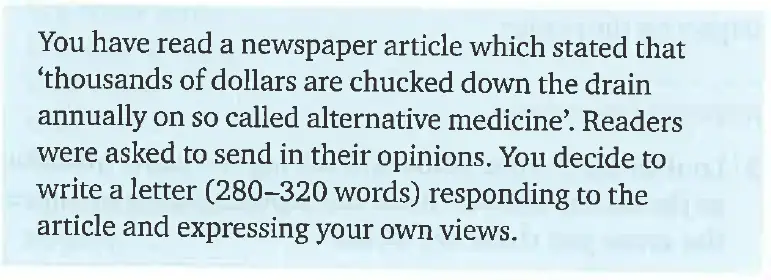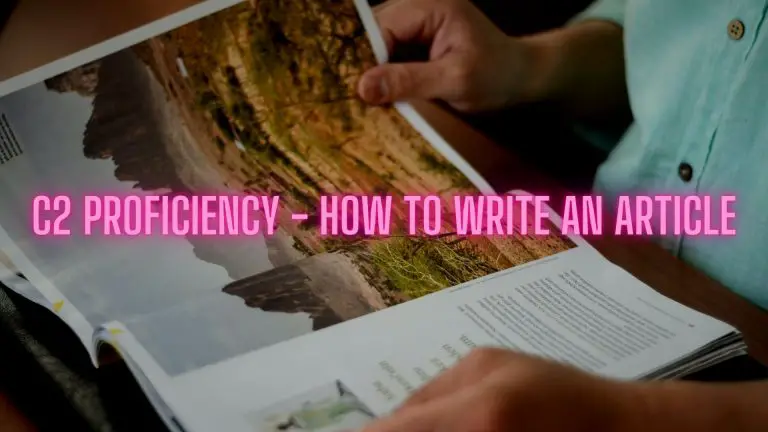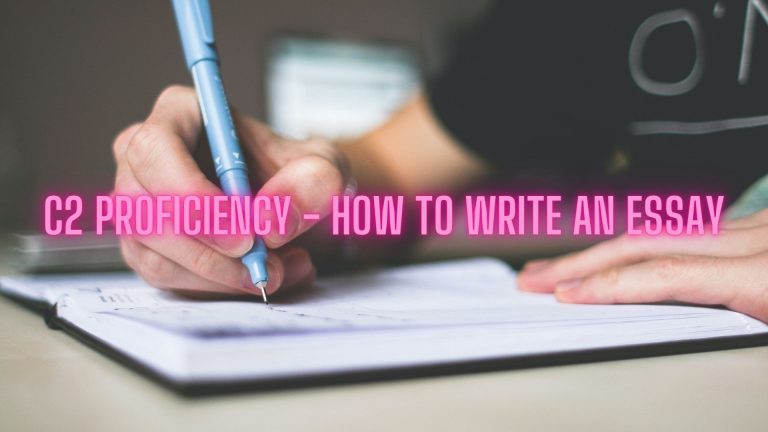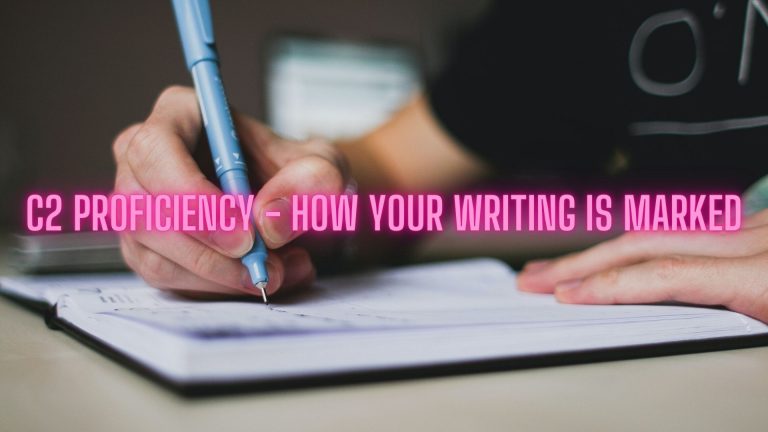Overview
- Mandatory task: no
- Word count: 280-320
- Main characteristics: opinion, narration, factual information
- Register: depends on the task
- Structure: greeting & opening paragraph, main paragraphs, closing paragraph & salutation
Introduction
A letter is written in response to the situation outlined in the question. Letters in the C2 Proficiency Writing paper will require a response which is consistently appropriate for the specified target reader, and candidates can expect to be asked to write letters to, for example, the editor of a newspaper or magazine, to the director of an international company, or to a school or college principal. A letter to a newspaper or magazine may well include a narrative element which details personal experience; other letters may be more concerned with giving factual information.
Source: Cambridge English Assessment: C2 Proficiency Handbook for teachers
A letter in Cambridge C2 Proficiency is not a mandatory task as it is one of the options in Part 2 of the writing test together with articles, reviews and reports. The only type of text that you have to write is an essay.
Letter writing is very straightforward
Most candidates don’t mind writing a letter in C2 Proficiency because we all communicate regularly via email and through other means so we are familiar with the typical layout and structure that letters require.
I often see very good results with my own students and in the internal exams we run at the school I work for or in the official exam, this is a very popular choice that seems to pay off for most.
So, we are going to work through an example together and see what it is that you need to be careful with from analysing a task all the way to writing your name at the end of the text.
What a typical letter task looks like
Task for a letter in C2 Proficiency always look fairly similar and are based around the idea that you want to respond to something that you have read about without giving you the source material itself. That means that you have to build you letter based on your opinion on the topic in the task. It is almost like an essay with more stylistic freedom, but before I get ahead of myself let’s have a look at an example task.

As you can see, there is not a whole lot of information. Instead, there is just an excerpt from a newspaper article and you should write a letter outlining your opinion on said statement.
To make our lives easier and to get out as much as possible of a task like this, we should always try to find the answers to the following three questions:
- What is the topic of the text?
- What exactly do I have to include in my text?
- Who is going to read the text?
The topic of our letter is alternative medicine and the question if it is a waste of money or not. Unfortunately, there isn’t any more specific information available so we will have to think about the different arguments and structure of the letter ourselves, but more on that in a moment. Finally, we are writing to a newspaper so there will be a wide variety of people reading what we have to say so that tells us that we should probably use a formal to neutral style of language, meaning that there shouldn’t be any colloquial expressions and we should try to avoid informal phrasal verbs.
How to organise your letter
Choosing a paragraph structure for your letter is one of the biggest steps towards success in C2 Proficiency. It gives you something to hold on to and in the next section we are going to fill it with life.
So, thinking about a letter we know that there is always a greeting and opening paragraph at the beginning as well as a closing paragraph and salutation at the end. In between, we add a few main paragraphs where we discuss the topic question, which leads us to this:
- Greeting & opening paragraph
- Main paragraphs
- Closing paragraph & salutation
If you keep this basic structure in mind, you are already on the right track. As mentioned before, the number of main paragraphs can vary depending on your ideas for each individual task but I want to give you a rough shape that we can then fill out and refine.
Always plan your letter before you start writing
Those of you who have read any of my other articles on writing, be it for A2, B1, B2, C1 or Proficiency, know that I’m a big fan of making a plan in order to set yourself up for a smooth ride. Not only does a good plan serve a storing space for your ideas so you won’t forget them once you start writing, but it also saves you tons of time as you will never have to rearrange paragraphs or rethink what you want to say. It’s all there and guides you through the process.
To create your plan, simply use the paragraph structure from earlier and organise your opinions and ideas within that framework. Let’s see what I came up with for our example task:
- Greeting & opening paragraph: why I’m writing, I fully agree
- Main paragraph 1: acknowledge other side – for minor illnesses alternative medicine does no harm, gives people something to believe in, placebo effect also works
- Main paragraph 2: contrast – placebo effect doesn’t justify the cost; charlatans take advantage of people
- Main paragraph 3: some alternative treatments can be harmful; people put their last hope in these methods
- Closing paragraph & salutation: ineffectiveness doesn’t justify use of alternative methods and people lose money
Making a plan like the one above is really simple, takes just a few minutes and makes your life so much easier. You should try it. It really helps.

The different parts of a letter
We are prepared and ready so the last thing we need to do is write the letter. Trust your plan and everything will be fine.
I am going to show you step by step how I would go about it so you get a better idea of what you should do to score higher marks in C2 Proficiency.
Greeting & opening paragraph
Every letter starts with a greeting and an opening paragraph where we state why we are writing or we react to a letter we’ve received. In C2 Proficiency, it is always the former, but, as we have to give our opinion on the topic in the task, we can do that straight away and let the reader know in the opening paragraph.
Going back to our example task from earlier about alternative medicine, a beginning might look like this:
Dear Sir/Madam,
I am writing in response to the article on alternative medicine published on August 1st and would like to share my opinion with you and the other readers. I would definitely agree that alternative medicine, for the most part, is a waste of money and time and that it would be wiser to use the full range of scientifically tested and proven methods to combat one’s health issues.
You can see that I didn’t have to do anything out of the ordinary to get started. I state the purpose of the letter (“I am writing in response to …”) and give my opinion (“I would definitely agree …”) without simply copying the wording from the task but rather paraphrasing and using my own words. That’s all you need to do and just like that we can move on to the next part.
Main paragraphs
Letters in Cambridge C2 Proficiency are a little bit like very opinionated essays with a lot more bias on our part. However, it is always a great idea to show good organisational skills by acknowledging the other side of the debate as well. That’s why I like starting with a paragraph outlining what someone disagreeing with me might say before I present my side of the argument.
Having said that, I do understand that for some, alternative approaches to minor ailments are preferable as they usually come with no side effects and have been used for generations. What worked for our grandparents has to work for us nowadays as well, doesn’t it? People like the idea of believing in something and being in control of their healing process and alternative medicine gives them exactly that. If it is the herb itself or just the placebo effect that’s at work, is secondary as long as it eases the suffering.
In the paragraph above I describe why some people prefer alternative medicine to established Western medicine. I introduce the paragraph with a contrasting expression (“Having said that, …”) to highlight that what comes next doesn’t reflect my opinion as stated in the opening paragraph. Cohesion and coherence are the name of the game in C2 Proficiency writing so make sure that all your ideas are well connected and logically organised.
In addition, I try to include a variety of vocabulary (alternative approaches, minor ailments, side effects, healing process, placebo effect, eases the suffering) related to the topic to engage the reader and keep their attention.
Following this first main paragraph, I tend to add two more paragraphs in which I support my own ideas on the topic. For me, it looks better if there are two paragraphs supporting my argument against only one for the other side. Of course, feel free to structure your letter as you want, but I think the way I do it makes sense.
However, the placebo effect doesn’t justify the often hefty price tag attached to these kinds of treatments and there are plenty of charlatans, like faith healers and snake oil salesman, who try to prey on the vulnerable with their promises of fast and lasting improvements through overpriced treatment sessions or products.
Many put their last hope and money into these quacks, herbs and potions only to have them shattered leaving them with an empty bank account on top of their broken bodies and minds. None of this helps people and should rather be considered criminal behaviour.
In these two paragraphs I focus on two aspects: the price of many alternative treatments and the, in my opinion, criminal energy many self-proclaimed healers and therapists squeeze money out of people who are often desperate and clinging to the last shred of hope they have left. The sections contrast the first main paragraph very well and show what I think about the topic.
Remember, a letter like this is all about your opinion so you can use strong arguments and the language to drive your point home.
Closing paragraph & salutation
To round off your letter you should always write a last paragraph which summarises your stance on the issue in the task.
To cut a long story short, I think that everyone can do with their money as they please, but the ones that are to blame are those defrauding people who just want to live a life free of pain and worries. Governments should introduce more oversight to ensure that money isn’t flushed down the toilet anymore but instead used to truly help people. I look forward to following subsequent articles on related issues.
Yours faithfully,
Teacher Phill
I restate my opinion very clearly here and even paraphrase the quote from the task (“… that money isn’t flushed down the toilet anymore …”). Lastly, I express that I would like to read more on the topic and end the letter with a typical salutation.
Summary
That is all you have to do to write a great letter in C2 Proficiency. With a little bit of planning the paragraph structure you want to use and the content of each of those sections you can set yourself up for a successful writing session where you can focus on using the best language possible, engaging the reader and writing in a cohesive and coherent way.
If you are interested in practising with yours truly, I offer writing feedback as well as online classes and I would love to hear from you so I can help you on your journey to pass Cambridge C2 Proficiency.
Lots of love,
Teacher Phill 🙂







